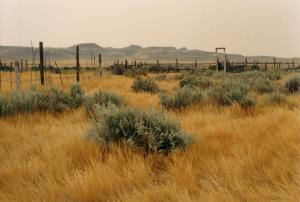
Grasslands National Park consists of two blocks. The West Block is based in the Frenchman River Valley, and the East Block in the Killdeer Badlands of the Wood Mountain Uplands, along the 49th parallel. The area is characterized by a mixed short grass prairie, intersected by coulees with exposed hillsides and shrubby vegetation protected in places from the strong winds. Some low-lying areas support wetland meadows. The major grass species are blue grama, needle-and-thread, and western wheatgrass. There are myriad native wildflowers.
The short grass prairie is home to a number of animal species, some of which are prairie specialists. The most obvious are such large mammals as the pronghorn and coyote, as well as the black-tailed prairie dog, which is found only here in Canada. Birds such as ferruginous hawk, burrowing owl, sage grouse and other dry grasslands birds, are seen. The threatened Western rattlesnake is known to have a number of denning sites in the coulee slopes and can be seen in the summer moving across the prairie as it hunts small rodents.
The short-grass prairie habitat was once of considerable expanse in southern Saskatchewan. During the plowing of the prairie for agriculture, it was broken up into smaller blocks and began to be greatly reduced. With the breaking of the prairie, the complex plant communities were replaced by single-species crops, along with attendant European weed species. This loss of the plants meant the loss of many herbivorous insects and rodents, with attendant loss of the carnivores. In 1956, the Saskatchewan Natural History Society recommended the establishment of a National Park to preserve remnants of this grasslands ecosystem. In 1981, Canada and Saskatchewan agreed to establish Grasslands National Park; final agreement was signed in 1988. Land acquisition continues by purchase on a willing seller/willing buyer basis. The planned park, on completion, will encompass 900 km2. The effectiveness of the conservation of the short-grass prairie is increased by programs of several other bodies to purchase adjoining remnants of prairie, and by property owners willing to retain lands in their natural state or to reclaim land by seeding with natural species. The establishment of the park also affords protection to the fossil sites in the area, where dry conditions and exposed hillsides allow access to the Cretaceous seabed and shoreline strata.
Diane Secoy